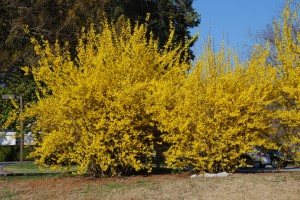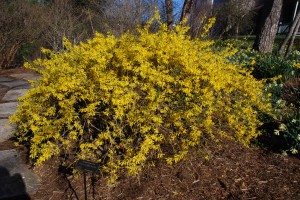In most areas of the U.S., the golden yellow blossoms of forsythia (Forsythia x intermedia) signals that worst of winter weather is almost over (USDA hardiness zones 4 to 8). Over 2-3 weeks bright yellow flowers cover this easy to grow shrub. Priced at under $20, a good-sized forsythia shrub is a bargain, often used to lure customers into the door.
Forsythias are small to medium-sized ornamental shrubs maturing between 4 to 10 feet tall by 5 to 12 feet wide depending on cultivar. It has an upright oval, open, growth habit with long arching growth habit. The shrub can easily take on a straggly appearance unless pruned every 1-2 years. Dwarf and semi-dwarf cultivars are available; the most popular form is Gold Tide™ at 3 to 4 feet tall and 5 to 6 feet wide.
Other popular cultivars include:
‘Sunrise’- compact 5 feet tall habit
‘Golden Nugget’ – grows to 5 feet tall and wide
’Spring Glory’ – 6 to 7 feet tall with pale yellow flowers and an upright habit.
‘Lynwood Gold’ – popular old fashioned cultivar with bright yellow blooms
‘Northern Sun’ – floral buds are hardy to -30°F.
Forsythia is best grown in full to partial sunlight (minimum 6 hours sun for best flowering). The shrub flowers less and branches grow tall and lanky in partial shade. It prefers moist, well-drained soils but adapts to poor soils, is not pH sensitive, and is very drought tolerant. It is rarely troubled by disease or pest troubles.
Vigorous growing forsythias are best pruned within 2-3 months after spring flowering. Most attention should be directed to remove thick (oldest) wood; this greatly will reduce the height of the shrub. Also remove weak basal suckers less than pencil thickness. Flower buds are set in mid- to late-summer. Late summer pruning should be avoided.
The 3 – 4 inch long medium green leaves turn an unexciting off-green, yellow, and purple in autumn before abscising. The olive to yellow-brown wood is covered with raised lenticels. Floral buds are evident by early fall and a few often flower during warm autumn days.
Forsythia is utilized as a specimen shrub or en masse as a deciduous hedge or intermediate privacy screen.



 Posted in
Posted in 
